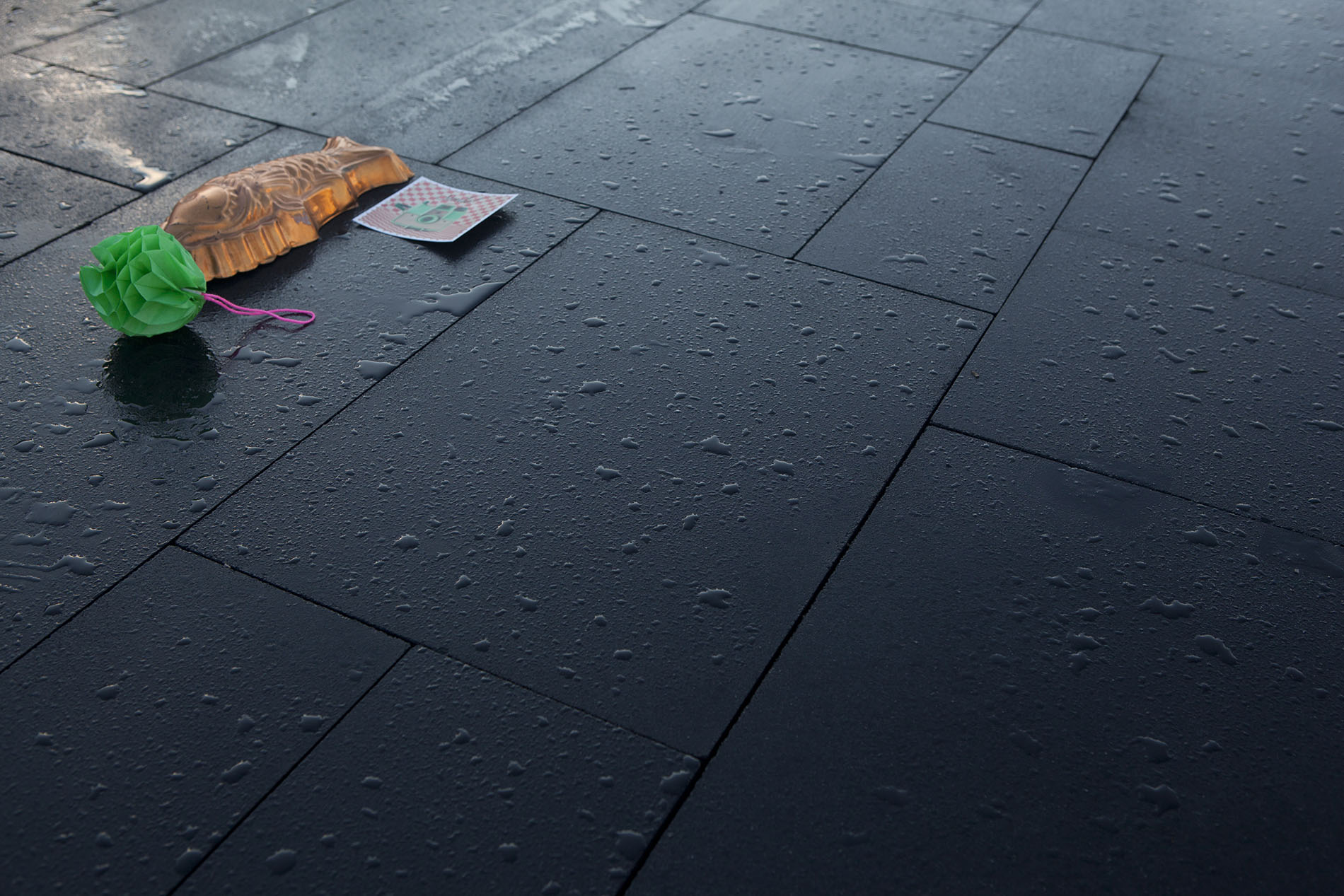Cleaning and maintenance for your patio
Patio cleaning
With nice weather we want to go outside and enjoy the garden. But the cold and wet weather has ensured that our outdoor furniture is covered with green deposit. And of course also the patio. A problem common to everyone, but how do you get rid of it quickly?
How can I best clean my patio?
It sounds very simple, but it is best to clean your patio with water. Synthetic cleaning agents can damage your decorative paving and we therefore advise against it. Read all about cleaning your patio on this page.
Cleaning agents
In this page we will discuss the use of various cleaning products and what you should and should not use. A frequently asked question is about cleaning vinegar. We advice against cleaning your terrace with vinegar, as it can damage certain types of tiles and grass surrounding your terrace. Cleaning agents that you might be using are:
- Green soap
- Steam cleaner
- High pressure cleaner
- Soda
- Biotex
Further down this page is explained in which situations you can best use which cleaning agent.
Unfortunately, everything outside turns green, regardless of the material. Look at your waste container, wood or glassware. The conditions that cause algae are moisture and cold. You probably also know that the waste container is faster to clean than another coarser surface textures. It is the same with your patio. The type of surface determines how easy it is to clean the patio.
A terrace that is always wet and damp will suffer from a lot of green deposits. A terrace with a lot of sunlight on the pavement can dry faster and the deposits disappears quickly. The choice you make when laying your tiles starts with this question. Is my patio in the sun or always in the shade? Terrace tiles have different types of top layers and there is a degree of ease of maintenance. One tile is easier to clean than the other tile. Your decorative paving specialist can give the correct advice on this.
Cleaning products and equipment
Cleaning the terrace with green soap?
In case of normal green deposits, we recommend cleaning with clean and hot water. Nothing else. Synthetic cleaning agents can damage your pavement and therefore we do not recommend it. In principle, we also advise against the use of green soap. This has to do with the fact that the basis of this soap consists of oil and fats. And this can actually leave nasty stains in your concrete pavement (if you use too much). Algae dies at higher temperatures. Do you have a very bad algae tarnish? Then try to get the water temperature above 65 degrees. That’s the best natural cleaning agent out there.
Cleaning agent against algae and moss
Good cleaning products can be found at the paving specialist, do not experiment the same result with home remedies. Also choose a biological product to prevent damage to the other plants in your garden and our environment. Most biological products must be applied on a dry surface and contain natural enzymes/substances that to the job (dry weather is a requirement). After a short time, the green deposit will have largely disappeared and you can clean the rest with clean water. These agents can also be purchased at your paving specialist dealer, including our preferred choice of Allex (Lithofin) or Bionyx.
Cleaning the patio with a high-pressure cleaner
We do not recommend the use of standard high-pressure cleaners on our concrete products. This is because the strong water jet from a standard high-pressure cleaner can spray away the cement particles between the colour minerals. In principle, cement works like glue, the colour minerals can come off. In addition, you make the top layer porous, which means that algae gets even more room to nest and the problem gets worse and worse at a faster rate.
If you still want to clean with a high-pressure cleaner, pay attention to the specifications: nominal pressure must not exceed 140 bar and the minimum distance between the outlet of the lance and the tile must be at least 20 centimeters! Tiles can be cleaned more safely with a power scrubber.
Ceramic outdoor tiles and GeoCeramica® can be cleaned with high pressure. These top layers are much harder. But always be careful with the joints.
Cleaning with vinegar, soda, biotex
Cleaning vinegar
It is true that weeds don’t like cleaning vinegar and algae don’t really like it either. So it seems like an ideal home remedy to quickly clean the patio. However, vinegar is just as aggressive as chemicals and in large quantities not good for the rest of the garden (that applies to normal cleaning vinegar as well as natural vinegar).
Soda
Soda is a chemical cleaning agent. Chemicals and nature do not mix well. In addition, soda is not very effective on green deposit. As far as we are concerned, don’t use soda in your garden.
Biotex
Biotex is often mentioned as a home remedy. The advantage of Biotex is that it would have less impact on the environment (we lack data on this). But the effect is a lot less and it has to work for a whole day for a good result (apply diluted). Incidentally, we have never tested Biotex and it is unknown whether this can cause damage to the top layer of a concrete tile with frequent use.
Steam cleaner, ideal for a clean patio
Algae and mosses
Many people are annoyed by algae or mosses that settle on tiles in damp places, especially in the winter months. Still, these are generally quite easy to remove. This job is done quickly with environmentally friendly cleaning agents. You will find good cleaning agents at the paving specialist.
An alternative to cleaning agents is steam. As a result, algae and mosses die. You can easily wipe up the residue later.
Lichens
Lichens are a more persistent contamination. These consist of compounds of algae and fungi. They come in different shapes and colours. Sometimes they look crusty, but in other cases they are leaf, bush, or cup-shaped. The best control method is to ensure that the temperature of the lichens rise to 70 degrees Celsius thanks to steam. Do this in dry weather and an outside temperature of at least 15 degrees. The roots then die.
White spots on your patio
Efflorescence
Efflorescence is another phenomenon that occurs on cementitious materials (concrete). Under certain climatic conditions, a white lime (calcium) buildup appears. Cement forms a chemical reaction with water, creating free calcium/lime that deposits on the surface. This certainly has no negative consequences for the quality of the tiles or stones. Over time, the white buildup will also disappear. Despite all quality control, this phenomenon cannot be prevented. Make sure the tiles are well ventilated if you place flower boxes etc. on them to avoid markings.
Lime runoff in paving
Lime runoff (or lime stains) in ornamental paving is not necessarily a complaint. Concrete paving is made from cement, sand, gravel and water. Under certain climatic conditions, efflorescence can occur on the surface of concrete products. This phenomenon is characteristic of cement-bound materials and is almost impossible to prevent. The cement can chemically react with water that can be in the tile or in the substrate of the pavement, which forms lime on the surface. This does not affect the quality of the product in any way and under the influence of the same climatic conditions and through the daily use of the paving, this buildup will greatly decrease over time and eventually disappear completely.
Of course it is also possible to speed up this process. This can be done with household products such as carbonated spring water and cleaning vinegar (always use acidic agents moderately to prevent damage!) Or by using a lime remover that you can purchase from your paving specialist.
Brown spots from leaves on your patio
At first, leaves on your tiles look very harmless. Unfortunately, those stray leaves or even those carefully raked piles of leaves can cause you a lot of inconvenience. After laying on your pavement for a while, they can leave erratic, brown spots. Unfortunately, these stains are difficult to clean off.
Always remove leaves as soon as possible!
Regular maintenance is the key to a beautiful terrace. Regularly wiping the leaves off your patio will prevent the acids from the leaves from penetrating into your tiles.
Cleaning
Existing stains will slowly disappear due to various weather influences. Sun usually has a positive effect on the spots. You can speed up this process by using mild cleaning products from the Bionyx and Lithofin range.




